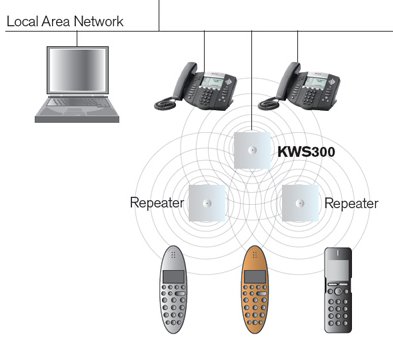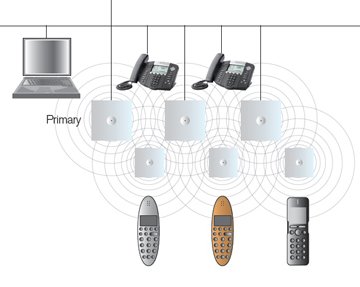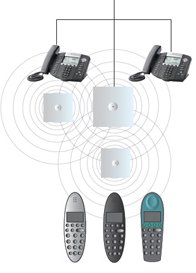We assemble a DECT puzzle based on Spectralink equipment
KIRK brand history
In March 2007, the well-known company Polycom, which is famous all over the world for its IP phones, as well as solutions for tele and video conferences, decided to expand its lineup towards wireless systems for IP telephony.
Polycom acquired SpectraLink Corporation for $ 220 million, which was engaged in the production of wireless telephone equipment based on Wi-Fi and DECT standards. At that time, KIRK Telecom was already in the concern.
Today, Polycom, or rather, its KIRK division, is a world leader in the production of DECT systems.
Of course, not only KIRK is engaged in DECT and VoIP, companies such as Pansonic (see. Panasonic KX-TGP500 DECT phone overview) and Siemens also work in this direction, but KIRK differs from them all in the level of its equipment.
The range of KIRK systems
KIRK manufactures equipment for both small and large companies, the KIRK product line is divided into two parts:
- Wi-Fi equipment, specifically Wi-Fi IP phones
- DECT systems and handsets discussed in this review.
Depending on the number of users and the required coverage, KIRK (Spectralink) offers different models of equipment, we will start with small systems and end with large ones.
KIRK 300
The KIRK 300 system will give us the opportunity to connect up to 12 subscribers and provide 4 simultaneous calls (4 channels).
This small base station will cover a room of up to 50m and provide coverage of up to 300m in direct line of sight.
The purpose of this device is to convert our SIP call to DECT and transfer it to the end DECT subscriber. To do this, up to 12 SIP users are added to the KIRK 300, and each one is tied to its DECT handset.
To increase the coverage of the DECT signal, KIRK (Spectralink) offers the use of repeaters (I will talk about them below).

KIRK 600v3
KIRK 600v3 is the only DECT / GAP base station (BS) with support for SCCP and SIP protocols. The KIRK 600v3 system can be used both in SingleCell mode and in MultiCell. In SingleCell mode, KIRK 600v3 supports 35 subscribers and 12 channels. In MultiCell mode, KIRK 600v3 supports up to 1,500 subscribers.
To enable MultiCell mode, you need to purchase a separate key, which is installed in KIRK 600v3 and makes it a master.
In MultiCell mode, the number of users can be increased up to 1500, and the coverage will also increase accordingly as new base stations (BS) are added. Most importantly, all BSs must see each other, their coverage areas must intersect, this is necessary for synchronization and handover.
Multicell

SingleCell

KIRK 6000
In the KIRK 6000 system , unlike the KIRK 300 and 600v3, the server that is responsible for SIP and the base station are two different devices. This allows you to build large and inexpensive DECT networks.
Thus, the KIRK 6000 Controller acts as a SIP server and BS control.
The maximum number of users in the system is 4096, however, upon the initial purchase of the controller, a license is included in it that supports up to 30 users, and then with the help of additional licenses their number can be increased.
The controller is also limited by the number of channels in the SIP network, more precisely, it can process only 32 channels, but the number of channels can also be increased by purchasing the KIRK6000MR Media Resource Controller, which will expand the number of SIP channels by another 32. In total, up to 31 KIRK6000MR can be connected to the system.
Also in KIRK 6000 you can add support for g.729 and g.723 using the codec board , the board is bought separately and installed in the system controller and in each media controller.
To cover the DECT network, KIRK (Spectralink) 6000 Base Stations are used , their maximum number in the system is 256, each BS supports up to 12 radio channels and extends coverage by 30-50m.
All Base Stations must intersect for synchronization and handover.
All parts of the system are connected to the local network and support POE, the controller and the media controller can be separated from the DECT network itself, they are synchronized over the local network.

WRFP
KIRK WRFP repeaters can increase DECT coverage by about 50%.
The repeater is attached to a specific base station or to another repeater and increases its coverage.
It should be noted that the maximum number of repeaters that can be connected in a row is 3 pieces. This limitation exists because repeaters support up to 4 DECT channels, and one of these channels is used to synchronize with a BS or with another repeater.
UPDATE: A new model of KIRK 400
PS has been released. If this introductory article about KIRK is pleasant to habrowsers, then the following will be a specific solution based on KIRK6000 and Asterisk.
PPS All KIRK in stock at http://kirk.su
